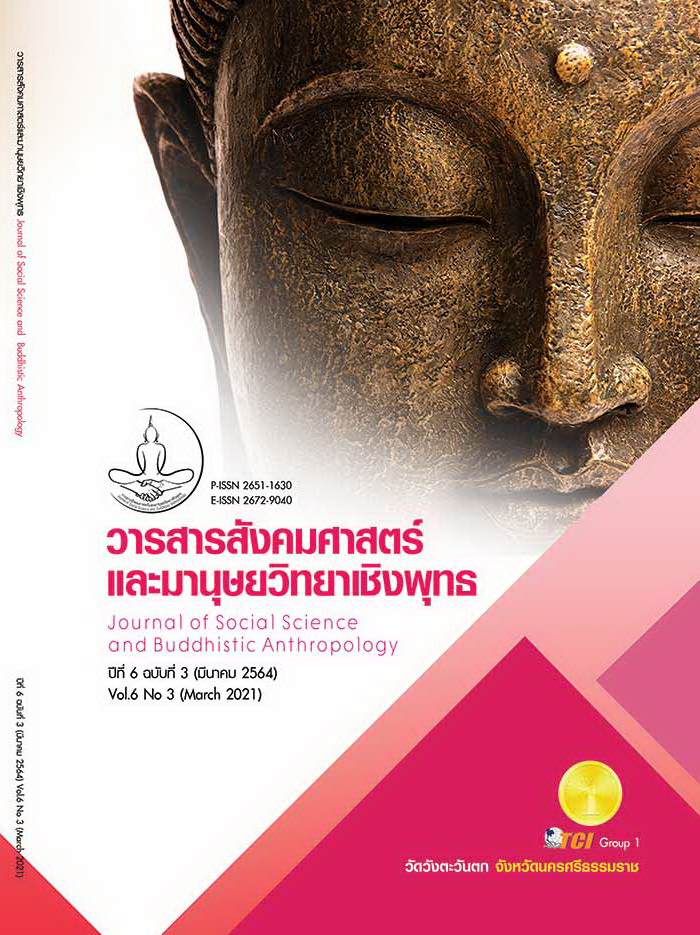PATRIOTISM IN CHILDREN’S LITERATURES OF THAILAND AND SINGAPORE
Keywords:
Patriotism, Children’s Literatures of Thailand, Children’s Literatures of SingaporeAbstract
The objectives of this article were to study the patriotic ideals of Thai and Singaporean children's literature. There were 55 stories have been used in this study and categorized into 40 Thai children's literature awarded by Office of the Basic Education Commission (OBEC) and 15 highly acclaimed Singaporean children's literature. A textual analysis of children’s literature works was utilized as a tool for data collection and described in analytical manner. From this study, it can be found that the content can be classified into 2 categories of children's literature: category 1 is a group that expresses the media content of 14 implicit patriotic ideologies, and category 2 is a group that shows content in the media showing the ideology of patriotism and connotation of 41 stories. In this regard, Thai children's literature presents an ideology of patriotism, both direct and implicit, such as nation, religion, and monarchy, while Singaporean children’s literature presents a patriotic ideology, namely leader, leadership qualities, ethnic diversity and family. Instilling a sense of patriotism as found on Thai children’s literature will shape cognition for children and juvenile, creating a good harmonious sense to happily live in the same country, while in Singaporean literature, it presents a benefit of good international relations, global affairs related to human activities, racial diversity and recognition of racial differences under the same country in peaceful manner. Similarity of Thai and Singaporean is peacekeeping and harmonious mindsets under the differences and cultural diversities, while the dissimilarity is Thai literature presenting the application of Buddhism as a guidance in the way of life; on the other hands, this is not the case in Singaporean literature.
References
เกรียงไกร กองเส็ง และสุภาวดี ยาดี. (2562). แผนภูมิสวรรค์” (天干地支) กับการถ่ายทอดอุดมการณ์ผ่านคำทำนาย. วารสารมนุษยศาสตร์สาร มหาวิทยาลัยเชียงใหม่, 20(3), 11- 45.
ไชยรัตน์ เจริญสินโอฬาร. (2543). วาทกรรมการพัฒนา อำนาจ ความรู้ ความจริง เอกลักษณ์ และความเป็นอื่น. กรุงเทพมหานคร: วิภาษา.
ณิชาดา ทวีศิลป์. (2563). โขนไทย. กรุงเทพมหานคร: แฮปปี้คิดส์.
ณิชาวีร์ เพิ่มพูนปฏิพัทธ์. (2562). พระพุทธเจ้า พุทธปัญญาและชาดก. กรุงเทพมหานคร: ห้องเรียน.
ติณณา แดนเขตต์. (2560). กราบพระเจ้าอยู่หัวรัชกาลที่ 9. กรุงเทพมหานคร: ผีเสื้อ.
ไทยรัฐออนไลน์ (มิสแซฟไฟร์). (2561). 10 ปัญหาวิกฤติโลก เด็กยุคใหม่กลัวขึ้นสมอง. เรียกใช้เมื่อ 9 สิงหาคม 2563 จาก https://www.thairath.co.th/news/foreign/1217738
นิธิ เอียวศรีวงศ์. (2557). ชาติไทย, เมืองไทย, แบบเรียนและอนุสาวรีย์. (พิมพ์ครั้งที่ 3). กรุงเทพมหานคร: มติชน.
เพ็ชรี สุมิตร. (2557). ประวัติศาสตร์สิงคโปร์. กรุงเทพมหานคร: มูลนิธิโครงการตำราสังคมศาสตร์และมนุษยศาสตร์.
ราชบัณฑิตยสถาน. (2556). พจนานุกรมฉบับราชบัณฑิตยสถาน พ.ศ. 2554. กรุงเทพมหานคร: ราชบัณฑิตยสถาน.
สรณี วงศ์เบี้ยสัจจ์ และคณะ. (2547). หนังสือนิทานภาพสำหรับเด็กของไทยที่ได้รับรางวัล:การวิเคราะห์เชิงวรรณกรรมและวาทกรรม. ใน รายงานการวิจัย. คณะมนุษยศาสตร์ มหาวิทยาลัยเชียงใหม่.
สละ นาคบำรุง. (2553). การ์ตูนประวัติศาสตร์ชาติไทย ยุคสุโขทัย เล่ม 1 กำเนิดสุโขทัย. กรุงเทพมหานคร: อมรินทร์คอมมิกส์.
สำนักงานเลขาธิการสภาผู้แทนราษฎร. (2558). สภาปฏิรูปแห่งชาติ. กรุงเทพมหานคร: สำนักงานเลขาธิการสภาผู้แทนราษฎร.
สำนักงานเสริมสร้างเอกลักษณ์ของชาติ. (2527). อุดมการณ์ของชาติ. (พิมพ์ครั้งที่ 3). กรุงเทพมหานคร: อมรินทร์การพิมพ์.
สุทธิลักษณ์ น้อยหร่าย. (2560). พระพุทธเจ้าศาสดาผู้รู้แจ้งด้วยตนเอง. กรุงเทพมหานคร: อมรินทร์พริ้นติ้งแอนด์พับลิชชิ่ง.
Amin, H. (2013). The Mango Tree. Singapore: Helang Books.
Lee, G. (2013). Little Cloud Wants Snow. Singapore: Marshall Cavendish International.
Ningmin, L. (2560). การวิเคราะห์หนังสือบันเทิงคดีสำหรับเด็กที่ได้รับรางวัลระหว่าง ปี พ.ศ. 2552 ถึงปี พ.ศ. 2558. ใน วิทยานิพนธ์ศิลปศาสตรมหาบัณฑิต สาขาวิชาภาษาไทย. มหาวิทยาลัยเชียงใหม่.
Yee, P. (2014). A Boy Named Harry : The Childhood of Lee Kuan Yew. Singapore: Epigram Books.
Yee, P. (2015). A Boy Named Harry : The Legacy of Lee Kuan Yew. Singapore: Epigram Books.








